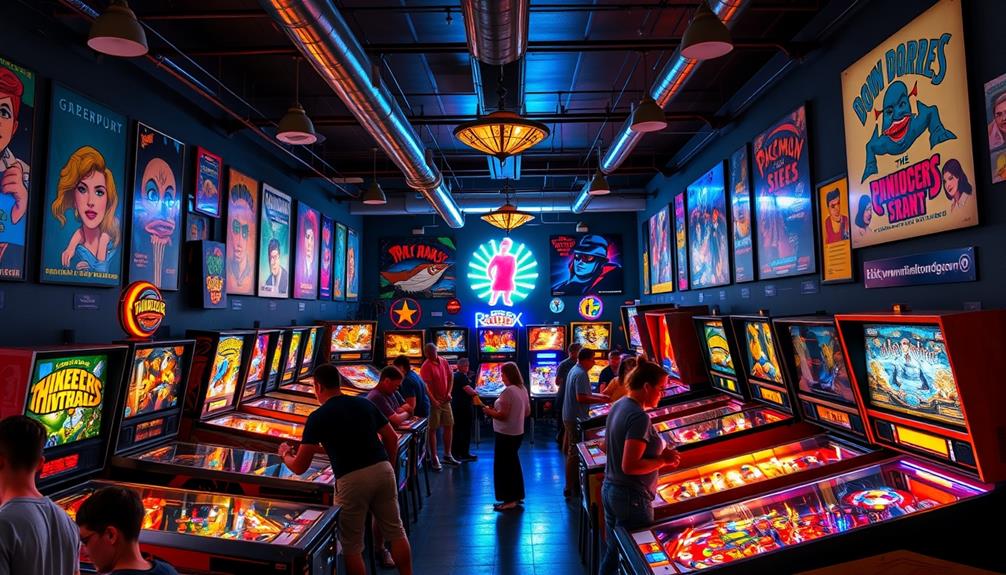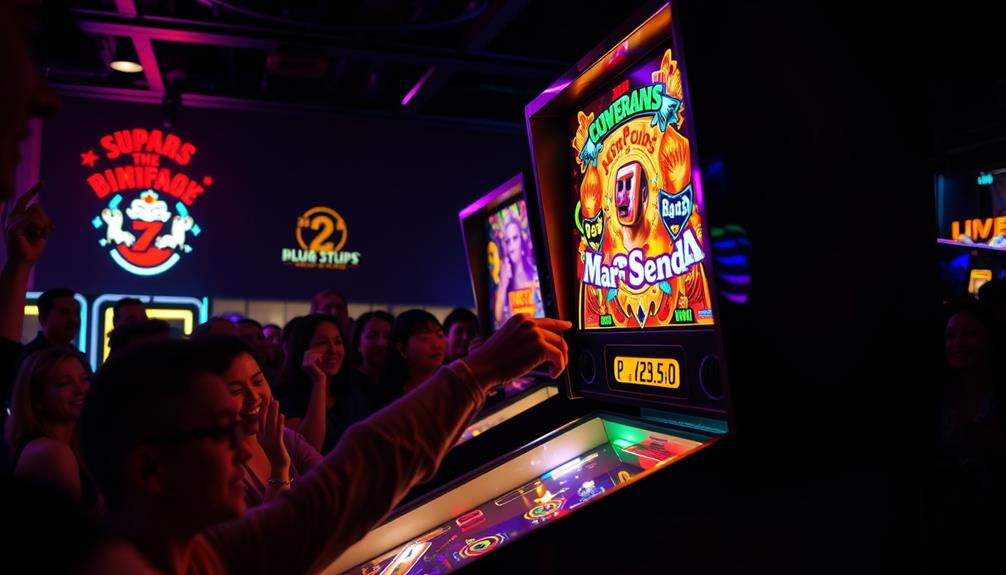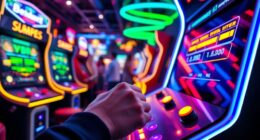Pinball was illegal in many parts of the United States from the early 1940s until the 1970s due to being viewed as a gambling threat associated with juvenile delinquency and organized crime. New York City Mayor Fiorello LaGuardia enforced a ban in 1942, resulting in the confiscation and destruction of numerous machines. However, perceptions began to shift in the 1970s as legal battles demonstrated that pinball was a game of skill rather than chance. This change ultimately led to the legalization of pinball in various cities. It is fascinating to explore how pinball evolved from a prohibited activity to a beloved pastime. Following the legalization of pinball, there was a resurgence of pinball arcades and a renewed interest in the game. Pinball machines were no longer associated with illegal behavior, but instead viewed as a source of entertainment and a social gathering place. Presently, pinball has maintained its popularity, with devoted fan communities and competitive leagues worldwide. The revival of pinball has cemented its status in popular culture, highlighting its enduring appeal and ability to unite people. If you are interested, you can learn more about the resurgence of pinball here: resurgence of pinball.
Key Takeaways
- Pinball machines were banned in New York City in 1942 due to concerns over gambling and juvenile delinquency.
- Mayor Fiorello LaGuardia led the crackdown, confiscating and destroying thousands of machines.
- Pinball was stigmatized as linked to organized crime and portrayed as a gambling racket in the media.
- Legal battles in the 1970s, including a pivotal California Supreme Court ruling, shifted the perception of pinball to a game of skill.
- The bans were lifted in the mid-1970s, leading to a resurgence in pinball's popularity and cultural acceptance.
Origins of Pinball
Pinball's roots trace back to the 18th century in France, where the game of bagatelle emerged as a popular tabletop pastime. This early game involved players launching a ball into holes using a cue, setting the stage for what would evolve into pinball.
Understanding the history of games like pinball can also highlight the importance of common financial terms and jargon in making informed decisions about investments and budgeting.
By the mid-19th century, bagatelle made its way to the U.S., transforming into a coin-operated pastime that captivated many.
In 1871, Montague Redgrave revolutionized the game by patenting the ball shooter, eliminating the need for a cue and paving the way for modern pinball machines.
The first true pinball machine debuted in 1931, marking a significant shift in the gaming industry as it changed from a parlor game to a commercial entertainment device.
Just two years later, the introduction of electric machines in 1933 brought automated scoring and sounds, enhancing gameplay and solidifying pinball's place in American culture.
As you explore the origins of pinball, you'll see how this game of skill evolved from humble beginnings into a beloved fixture in arcades and bars, eventually catching the attention of lawmakers like the New York City Council.
The Rise of Legal Bans

As pinball machines gained popularity in the early 20th century, they soon attracted the attention of lawmakers concerned about their potential for gambling. The perception of pinball as a game of chance led to an increasing number of legal restrictions across the U.S.
Importantly, New York City Mayor Fiorello LaGuardia spearheaded a vigorous campaign against pinball, culminating in a ban on pinball enacted on January 21, 1942. This ban saw thousands of machines confiscated and destroyed.
The debate around pinball also reflected broader societal concerns about emotional dysregulation in youth, as lawmakers feared that such games could exacerbate impulsive behaviors among adolescents.
Consider the factors driving this legal crackdown:
- Association with organized crime: Pinball was often linked to illegal gambling operations.
- Public concern over juvenile delinquency: Lawmakers viewed pinball as a corrupting influence on youth.
- Widespread legal restrictions: Many cities followed New York's lead, implementing similar bans.
- Cultural shift: Over time, attitudes towards pinball began to evolve.
In 1974, the California Supreme Court ruled that pinball was indeed a game of skill, leading to the gradual lifting of bans.
Public Perception of Pinball

During the 1940s, many people saw pinball machines as a serious threat to societal morals, linking them to gambling and organized crime. This public perception painted pinball as a moral menace, with New York City Mayor Fiorello LaGuardia describing it as a mob-controlled gambling racket. Such statements fueled widespread negative sentiment, resulting in significant bans across various cities.
The media sensationalized these connections, portraying pinball as a catalyst for juvenile delinquency. This narrative contributed to the game's stigmatization, depicting it as a corrupting influence on children. Additionally, the legal implications surrounding such perceived vices were a concern for the community, as seen in various legal processes like those involved in divorce cases where financial stability and moral considerations come into play. divorce financial implications
The public's response was intense, as evidenced by the staged destruction of confiscated pinball machines, designed to reinforce the idea that pinball was a pressing social issue needing eradication.
Even the introduction of flippers in 1947, which transformed pinball into a skill-based game, couldn't shake its negative reputation. Pinball machines continued to be associated with illegal activities, further entrenching their status as a vice to be controlled.
Ultimately, despite its evolution, pinball remained a target of societal scrutiny, reflecting broader anxieties about morality and the influence of perceived vices on the community.
Key Figures in the Ban

You can't talk about the ban on pinball without mentioning New York City Mayor Fiorello La Guardia.
His fierce campaign against the game highlighted broader concerns regarding moral implications of actions in society, framing it as a front for organized crime and gambling.
His aggressive actions, including the public destruction of machines, set the tone for the nationwide crackdown on pinball in the 1940s.
Fiorello LaGuardia's Campaign
In the early 1940s, Fiorello LaGuardia emerged as a formidable force in New York City's campaign against pinball, viewing the game as a gambling racket tied to organized crime. His administration took a hard stance, leading to the confiscation of over 2,000 pinball machines. LaGuardia believed that these machines exploited vulnerable citizens and posed serious risks to schoolchildren, linking them to juvenile delinquency.
This push for an improved community environment wasn't unlike the emphasis on wellness seen in practices like essential oils for respiratory health, which promote better living conditions for the public.
To bolster his moral campaign during wartime, LaGuardia staged public destruction of confiscated machines, creating a spectacle for the media. This was part of a broader effort to redirect focus toward the nation's wartime responsibilities.
Here's a snapshot of his campaign:
- Characterized pinball as a gambling vice.
- Confiscated machines were repurposed for wartime efforts.
- Linked the game to financial exploitation of youth.
- Publicly destroyed machines to showcase government action.
LaGuardia's campaign reflected not just a crackdown on pinball, but a commitment to combating organized crime and promoting a more virtuous society in New York City during a challenging time. His actions left a lasting impact on the perception of pinball and its role in the community.
Organized Crime Connections
LaGuardia's aggressive campaign against pinball machines didn't just stem from a moral standpoint; it was deeply intertwined with organized crime's grip on the industry. In the 1940s, pinball machines became synonymous with illegal gambling and money laundering, particularly in cities like Chicago. Mobsters controlled the distribution and operation of these machines, which led law enforcement to view them as tools of corruption.
This connection between crime and gaming reflects broader societal concerns about content relevance and authority in the face of emerging entertainment trends.
Key figures in the ban, including the Kings County District Attorney, testified that gangs were involved in running pinball operations. This testimony solidified the public perception of pinball as a criminal enterprise. High-profile raids by New York City Mayor Fiorello La Guardia underscored this connection, resulting in the confiscation and destruction of thousands of pinball machines.
Media sensationalism further exacerbated pinball's reputation, often linking the machines to juvenile delinquency and broader criminal activity. This negative portrayal influenced public opinion and regulatory actions, as many began to see pinball machines not just as games, but as symbols of organized crime.
Consequently, the fight against pinball was as much about controlling crime as it was about safeguarding community morals.
Pinball's Cultural Impact

You can't ignore how pinball's journey from a banned activity to a beloved pastime reflects broader cultural shifts.
The stigmatization of pinball as a vice fueled a counterculture that fought back through legal battles, ultimately transforming public perception. This transformation mirrors the resilience seen in other aspects of society, where humor and motivation often help individuals navigate through challenging changes, much like how inspirational quotes can uplift spirits during tough times.
Now, as you see pinball machines in bars and arcades, it's clear that nostalgia and retro revival play a huge role in celebrating this once-outlawed game.
Stigmatization and Counterculture
Pinball machines once occupied a controversial space in American culture, often linked to organized crime and juvenile delinquency. This connection fueled public fear and led to bans in cities like New York and Chicago. The sensationalized media painted pinball as a gambling menace, corrupting youth and inciting moral panic.
However, this stigma birthed a vibrant counterculture, reminiscent of the importance of nurturing an imaginative mindset. Players sought out illegal machines in underground venues, turning pinball into a symbol of rebellion.
Picture the scene:
- Dimly lit basements brimming with laughter and excitement.
- Players honing their skills while dodging authorities.
- A sense of camaraderie among those who defied the law.
- The thrill of nostalgia as machines echoed with classic sounds.
Despite its illegal status, pinball thrived, evolving into a cultural touchstone that represented defiance against societal norms.
As legal challenges emerged, particularly in the 1970s, public perception began to shift. The California Supreme Court ruling declared pinball a game of skill, paving the way for its acceptance.
Legal Battles and Repeals
Throughout the 1970s, a series of legal battles reshaped the landscape of pinball, transforming it from a criminalized pastime into a celebrated cultural phenomenon. Initially banned in many U.S. cities due to its association with gambling and juvenile delinquency, pinball faced strict prohibitions, particularly in New York City under Mayor Fiorello LaGuardia's moral campaign in 1942. This pinball prohibition history persisted until the 1970s, when a series of court cases challenged the stigma surrounding the game. The legal battles ultimately led to the legalization of pinball in many areas, as it became recognized as a game of skill rather than chance. This shift in perception allowed pinball to flourish as a legitimate form of entertainment, paving the way for its resurgence in arcades, bars, and homes across the country.
However, a pivotal moment occurred in 1974 when the California Supreme Court ruled that pinball was a game of skill, not chance. This shift catalyzed legal changes across several states, challenging the perception of pinball as simply illegal gambling. Coincidentally, this change in perception mirrors the cruise industry's evolution, where experiences like onboard authentic art auctions have enhanced leisure activities.
Roger Sharpe's successful demonstration of skill in 1976 was essential in overturning New York City's ban, marking a significant cultural transformation. The repeal of these restrictions led to a resurgence in pinball's popularity, with the game becoming a symbol of counterculture.
Competitive leagues and public events emerged, celebrating pinball as a legitimate form of entertainment. Ultimately, the lifting of bans reflected broader societal changes in attitudes towards gambling and leisure, solidifying pinball's place not just as a game, but as a cultural artifact in American society.
Nostalgia and Retro Revival
As pinball emerged from its years of prohibition, it quickly became a beloved symbol of nostalgia and retro gaming culture. The cultural shift in the 1970s, marked by legal recognition of pinball as a game of skill, sparked a resurgence that captivated a new generation.
No longer tied to organized crime, pinball machines transformed into icons of entertainment, drawing people together. This revival paralleled the growth of other online earning platforms, highlighting how various skill levels and interests can be monetized through best websites to earn money online.
Consider these aspects of pinball's cultural impact:
- Vintage Machines: Classic games evoke memories and connect enthusiasts to the past.
- Pop Culture: Iconic songs like "Pinball Wizard" helped embed pinball in the mainstream.
- Community Engagement: Barcades and dedicated venues foster connections among players.
- Contemporary Themes: Modern machines reflect today's music and films, bridging generations.
This revival not only honors the history of pinball but also enriches gaming culture today.
As you step into a pinball venue, you're part of a vibrant community celebrating both the vintage allure and the excitement of modern play.
Pinball represents more than just a game; it's a nostalgic journey that continues to resonate with enthusiasts and newcomers alike.
The Flipper Revolution

The introduction of flippers in 1947 marked a major turning point for the world of pinball, transforming it from a simple game of chance into an engaging skill-based experience. With the D. Gottlieb Company's game "Humpty Dumpty," players gained unprecedented control over the ball's trajectory, enhancing gameplay and strategy. This innovation shifted the pinball industry dramatically, allowing players to influence outcomes rather than relying solely on luck.
Even while pinball faced an illegal status in many cities, the flipper revolution fueled its resurgence in popularity. As players embraced this new skill-based game, public perception began to evolve. No longer viewed merely as a gambling device, pinball started to be recognized for its strategic elements and entertainment value.
The incorporation of flippers not only changed individual gameplay experiences but also led to increased design complexity within machines. The rise of themed machines emerged as a response to this transformation, appealing to a broader audience and paving the way for pinball's enduring legacy.
Ultimately, the flipper revolution was a significant step in reshaping pinball's future and setting the stage for its eventual legalization in various cities.
Legalization Efforts in the 1970s

Momentum for pinball's legalization surged in the 1970s, fueled by a growing recognition of its skill-based nature. In 1974, the California Supreme Court declared pinball a game of skill, sparking a wave of legalization efforts across the country.
This cultural shift was highlighted by Roger Sharpe's impressive demonstration in New York City in 1976, where he showcased pinball's strategic gameplay, helping to overturn the city's long-standing ban.
As pinball gained acceptance, other cities followed suit, including Chicago in 1977. The legalization efforts transformed pinball from a stigmatized pastime into a celebrated form of entertainment.
You could feel the excitement in the air as:
- Pinball machines filled arcades and bars.
- Families flocked to entertainment venues.
- Competitions began to emerge, showcasing skilled players.
- A vibrant pinball culture emerged, connecting enthusiasts.
Legacy of Pinball Prohibition

Pinball's journey from a banned activity to a beloved pastime has left a lasting legacy that reflects broader societal changes.
The pinball prohibition of the 1930s, spearheaded by figures like Mayor Fiorello La Guardia in New York City, framed the game as a threat tied to gambling and juvenile delinquency. Thousands of machines were destroyed, illustrating a deep-rooted fear of moral decay.
However, the California Supreme Court's 1974 ruling that pinball was a game of skill marked a significant legal shift. This decision catalyzed the gradual legalization of pinball across states, including New York in 1976.
Frequently Asked Questions
Why Was There a 35 Year Ban on Pinball?
There was a long ban on pinball because authorities viewed it as a gambling threat and a source of juvenile delinquency. Concerns about organized crime and moral decay fueled the backlash against this popular pastime.
Why Was Pinball Illegal in NYC?
You'd think a simple game like pinball wouldn't cause a fuss, but in NYC, it was deemed a gambling menace. Authorities linked it to organized crime, claiming it corrupted youth and threatened school finances.
Why Were Pinball Machines Illegal in California?
Pinball machines were illegal in California primarily due to their links to gambling and organized crime. Authorities viewed them as moral threats, particularly to youth, fueling widespread bans across various cities during the 1930s and 1940s.
Where Is Pinball Still Illegal?
In some places, pinball's like a ghost, haunting the streets where it's still illegal. You'll find restrictions in certain New Jersey towns, parts of Michigan, and remnants of bans in smaller jurisdictions across the country.
Conclusion
You might think pinball's just a fun game, but its history reveals a battle for acceptance. Once banned and shunned, it transformed into a beloved pastime, thanks to passionate advocates who fought for its legalization. Embracing the flipper revolution not only changed the game but also shifted public perception. Today, pinball stands as a symbol of resilience and creativity, reminding us that even the most playful of activities can face serious challenges and ultimately emerge victorious.









